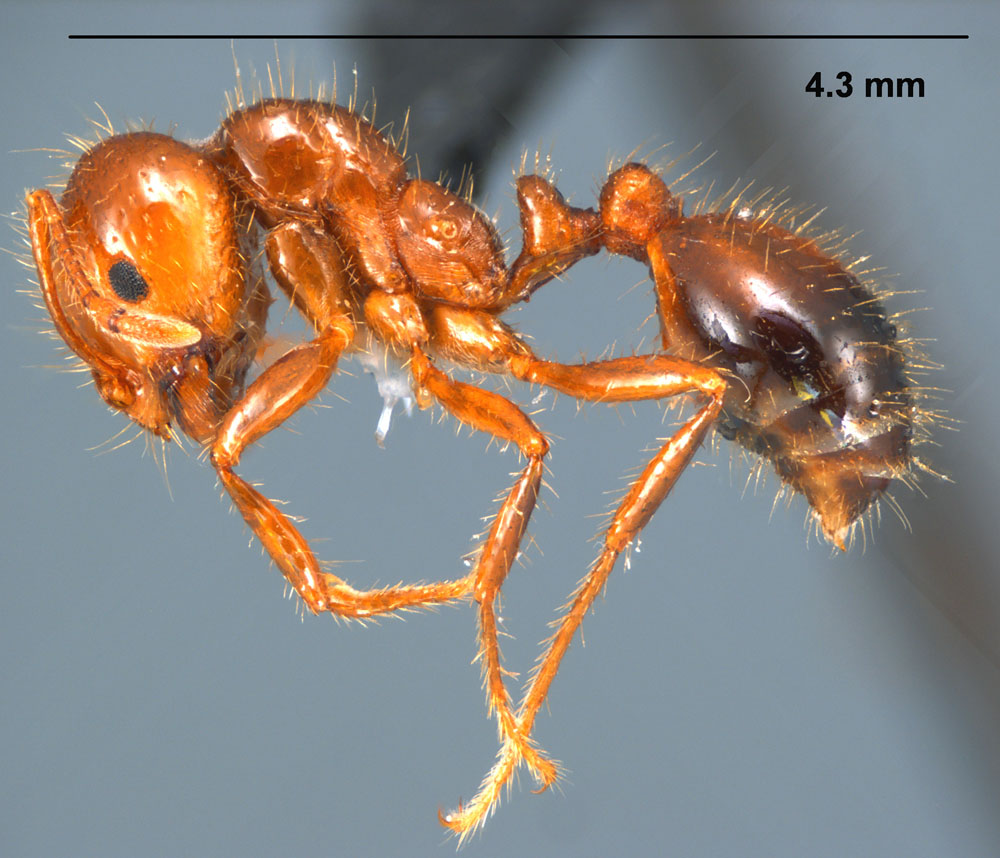Classification
Domain: Eukarya
Organisms in this domain are classified as having cells with a
nucleus and membrane-bound organelles (Encylopedia of Life 2013).
Kingdom: Animalia
Organisms in the diverse kingdom Animalia are multicellular and
heterotrophic, meaning that they must consume other organisms to
obtain nutrients (Encyclopedia of Life 2013).
Phylum: Arthropoda
S. invicta are classified as Arthropods because they have
bilaterally symmetrical, segmented bodies, jointed appendages, and
hard, chitinous exoskeletons (Encyclopedia of Life 2013).
Class: Insecta
Members of class Insecta are known to have the following features:
three pairs of legs, a body segmented into a head, abdomen, and
thorax, and two antennae on the head. S. invicta also
encompasses the trait of being capable of flight, which is also a
feature of insects (Encyclopedia of Life 2013). Some other insect
examples include
Eristalis transversa,
Chauliodes pectinicornis, and
Stenonema pulchellum.
Order: Hymenoptera
Order Hymenoptera includes ants, bees, and wasps. S. invicta
belongs to sub-order Aculeata, which include eusocial ants
(Encyclopedia of Life 2013). They exhibit cooperative
care of the young, labor division, and an overlapping of generations
in their colonies (Entomology and Plant Pathology 2013). A few
other organisms in the order include
Pelecinus polyturator,
Sceliphron caementarium,
Camponotus pennsylvanicus, and
Anoplius aethiops.
Family: Formicidae
S. invicta belong to this family because they have a very
narrow thorax and a metapleural gland to help fend off bacteria and
fungi (Encyclopedia of Life 2013). Other example of organisms in
this family include
Eciton hamatum,
Paraponera clavata, and
Polyrhachis lamellidens.
Genus: Solenopsis
Many members of this genus, including S. invicta, are
reddish-brown in color. This genus of ant also stings invaders
and prey (Encyclopedia of Life 2013).
Species: Solenopsis invicta
S. invicta, known as the Red Imported Fire Ant in
English, is an invasive species of stinging ant. Invasions of
this species are a potential worldwide threat, and the United States
especially has spent great deals of money trying to eradicate this
pesky species, with efforts continuing to this day (Encyclopedia of
Life 2013). This species in particular is very efficient at
reproduction, and can either have single or multi-queen nests
(Taber 2000). More can be learned about this particular species
here :
http://eol.org/pages/403244/details.
Phylogenetic Trees
The phylogenetic tree below shows the relationships between some of the orders in class Insecta. Solenopsis invicta belongs to order Hymenoptera, which includes ants, bees and wasps. The tree is based upon morphological characteristics. Archaeognathan and Zygentoma are in the outgroup because they have the least synapmorphies similar to Hymenoptera. Synapomorphies, which are shared, derived characteristics, that both Hymenoptera and its sister taxa Diptera/Lepidoptera have include folded wings and holometabolous larvae. The folded wings are an advantage over unfolded wings by offering a way of protecting these delicate structures. Holometabolism is complete metamorphosis including egg, larva, pupa, and adult stages (Smithsonian Marine Station 2007).

 This phylogenetic tree
is based off of the
Hymenoptera genome. S. invicta is sister to the clade
including A. echinatior and A. cephalotes,
which includes species of leaf cutter ants.
The tree was created to compared antimicrobial peptides (AMPs),
which are necessary for insect immunity (Zhang and Zhu 2012).
The aforementioned leaf cutter clade contains the same number and
type of five different AMPs, which is one of the reasons they are so
closely related on the tree. S. invicta also has the
same number and category of three of those types of AMPs as its
sister clade, but contains far more of the remaining categories
(Zhang and Zhu 2012). This is one reason why they are closely
related but not all sister taxa. The high amounts of other
AMPs such as defensin that S. invicta have may greatly protect them
against bacteria and fungi, and may be a contributing factor to the
success of the species. On this phylogentic tree, S.
invicta is most distantly related to the fly D.
melanogaster, which also has far fewer antimicrobial peptides
(Zhang and Zhu 2012). For more information about AMPs in
different species of Hymenoptera, visit
www.sciencedirect.com/science/article/pii/S0145305X12000900.
This phylogenetic tree
is based off of the
Hymenoptera genome. S. invicta is sister to the clade
including A. echinatior and A. cephalotes,
which includes species of leaf cutter ants.
The tree was created to compared antimicrobial peptides (AMPs),
which are necessary for insect immunity (Zhang and Zhu 2012).
The aforementioned leaf cutter clade contains the same number and
type of five different AMPs, which is one of the reasons they are so
closely related on the tree. S. invicta also has the
same number and category of three of those types of AMPs as its
sister clade, but contains far more of the remaining categories
(Zhang and Zhu 2012). This is one reason why they are closely
related but not all sister taxa. The high amounts of other
AMPs such as defensin that S. invicta have may greatly protect them
against bacteria and fungi, and may be a contributing factor to the
success of the species. On this phylogentic tree, S.
invicta is most distantly related to the fly D.
melanogaster, which also has far fewer antimicrobial peptides
(Zhang and Zhu 2012). For more information about AMPs in
different species of Hymenoptera, visit
www.sciencedirect.com/science/article/pii/S0145305X12000900.
To learn more about S. invicta's habitat, click
here.
Click here to return to the home page.
